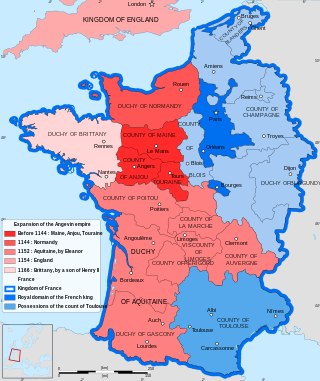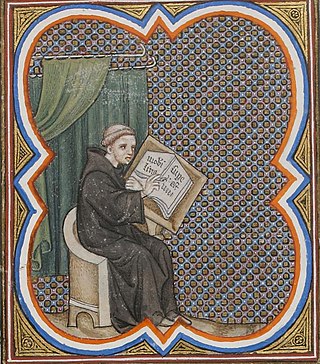The Duchy of Anjou was a French province straddling the lower Loire. Its capital was Angers, and its area was roughly co-extensive with the diocese of Angers. Anjou was bordered by Brittany to the west, Maine to the north, Touraine to the east and Poitou to the south. The adjectival form is Angevin, and inhabitants of Anjou are known as Angevins. In 1482, the duchy became part of the Kingdom of France and then remained a province of the Kingdom under the name of the Duchy of Anjou. After the decree dividing France into departments in 1790, the province was disestablished and split into six new départements: Deux-Sèvres, Indre-et-Loire, Loire-Atlantique, Maine-et-Loire, Sarthe and Vienne.

The Château d'Amboise is a château in Amboise, located in the Indre-et-Loire département of the Loire Valley in France. Confiscated by the monarchy in the 15th century, it became a favoured royal residence and was extensively rebuilt. King Charles VIII died at the château in 1498 after hitting his head on a door lintel. The château fell into decline from the second half of the 16th century and the majority of the interior buildings were later demolished, but some survived and have been restored, along with the outer defensive circuit of towers and walls. It has been recognised as a monument historique by the French Ministry of Culture since 1840.

The Château de Chaumont, officially Château de Chaumont-sur-Loire, is a castle (château) in Chaumont-sur-Loire, Centre-Val de Loire, France. The castle was founded in the 10th century by Odo I, Count of Blois. After Pierre d'Amboise rebelled against Louis XI, the king ordered the castle's destruction. Later in the 15th century Château de Chaumont was rebuilt by Charles I d'Amboise. Protected as a monument historique since 1840, the château was given into state ownership in 1938 and is now open to the public.

The Château de Montsoreau is a Flamboyant Gothic castle in the Loire Valley, directly built in the Loire riverbed. It is located in the market town of Montsoreau, in the Maine-et-Loire département of France, close to Saumur, Chinon, Fontevraud-l'Abbaye and Candes-Saint-Martin. The Château de Montsoreau is situated at the confluence of two rivers, the Loire and the Vienne, and the meeting point of three historical regions: Anjou, Poitou, and Touraine. It is the only château of the Loire Valley built directly in the Loire riverbed.
Ingelger, also called Ingelgarius, was a Frankish nobleman, who was the founder of the County of Anjou and of the original House of Anjou. Later generations of his family believed that he was the son of Tertullus (Tertulle) and Petronilla.
Geoffrey IV, called Martel, was Count of Anjou from 1103 until his early death, either co-ruling with his father, Fulk IV, or in opposition to him. He was popular with the Church and grew a reputation for curbing tyranny and opposing his violent father, who, according to Orderic Vitalis, enjoyed pillaging and terrorising his subjects.

The Chronicle of Fredegar is the conventional title used for a 7th-century Frankish chronicle that was probably written in Burgundy. The author is unknown and the attribution to Fredegar dates only from the 16th century.
Elias II was the younger son of Fulk V of Anjou and his first wife, Eremburga, daughter of Count Elias I of Maine. There is debate as to whether he was ever count of Maine or whether he merely made a claim to it.
Bisinus was the king of Thuringia in the 5th century AD or around 500. He is the earliest historically attested ruler of the Thuringians. Almost nothing more about him can be said with certainty, including whether all the variations on his name in the sources refer to one or two different persons. His name is given as Bysinus, Bessinus or Bissinus in Frankish sources, and as Pissa, Pisen, Fisud or Fisut in Lombard ones.

Bussy-le-Château is a commune in the Marne department in the Grand Est region of Northeastern France. In 2018, it had a population of 173. The inhabitants of the commune are known as Bussinais (masculine) and Bussinaises (feminine).

The house of Amboise was one of the oldest families of the French nobility whose followed filiation dated back to the early twelfth century. It took its name from the town of Amboise in Touraine.

The County of Anjou was a small French county that was the predecessor to the better-known Duchy of Anjou. Its capital was Angers, and its area was roughly co-extensive with the diocese of Angers. Anjou was bordered by Brittany to the west, Maine to the north, Touraine to the east and Poitou to the south. The adjectival form is Angevin, and inhabitants of Anjou are known as Angevins. In 1360, the county was raised into the Duchy of Anjou within the Kingdom of France. This duchy was later absorbed into the French royal domain in 1482 and remained a province of the kingdom until 1790.

Hildegarde of Burgundy was a French noble, Duchess consort of Gascony and Aquitaine by marriage to William VIII, Duke of Aquitaine.
René Poupardin was a French medievalist and paleographer whose most important works were on Burgundy, Provence and the south Italian principalities. He was an alumnus of the École nationale des chartes and a member of the École française de Rome from 1899 to 1902. He was studies director at the École pratique des hautes études and later a professor at the École des chartes. He also worked as a librarian at the Bibliothèque nationale de France. Born at Le Havre and died at Fontainebleau, most of his life was spent in Paris and Rome.

The Annals of Vendôme are a set of medieval annals covering events from 678 to 1347. They survive in a single manuscript copy, the exemplar of which came from the Abbey of the Holy Trinity at Vendôme.

Primat was a French Benedictine monk and historian of the abbey of Saint-Denis near Paris. He composed two histories of France with a royal focus, one in Latin and the other in Old French. His Latin chronicle covers the years 1248 to 1277 but now survives only in an Old French translation and in excerpts incorporated into the works of others. It contains a detailed account of the reign of Louis IX, making it one of the most important contemporary sources for that reign. His French chronicle, the Roman des rois, covers the entire history of France down to 1223. It was completed around 1274 for Philip III and its presentation copy is extant. It is the earliest version of what would become the Grandes Chroniques de France, the first official history of France.

The Chronica de gestis consulum Andegavorum, or simply Gesta consulum Andegavorum, is a Latin history of the Ingelgerian dynasty of the county of Anjou written in the early 12th century, probably between 1106 and 1109, during the second reign of Count Fulk IV.

The Gesta Dagoberti, fully Gesta domni Dagoberti regis Francorum, is an anonymous Latin biography of Dagobert I, king of the Franks (623–639). It combines deeds from the life of Dagobert with numerous accounts of miracles to present Dagobert as a saint and the founder of the Abbey of Saint-Denis. It was written in the early 9th century. As a historical source, it is "extremely unreliable", but not totally useless.












